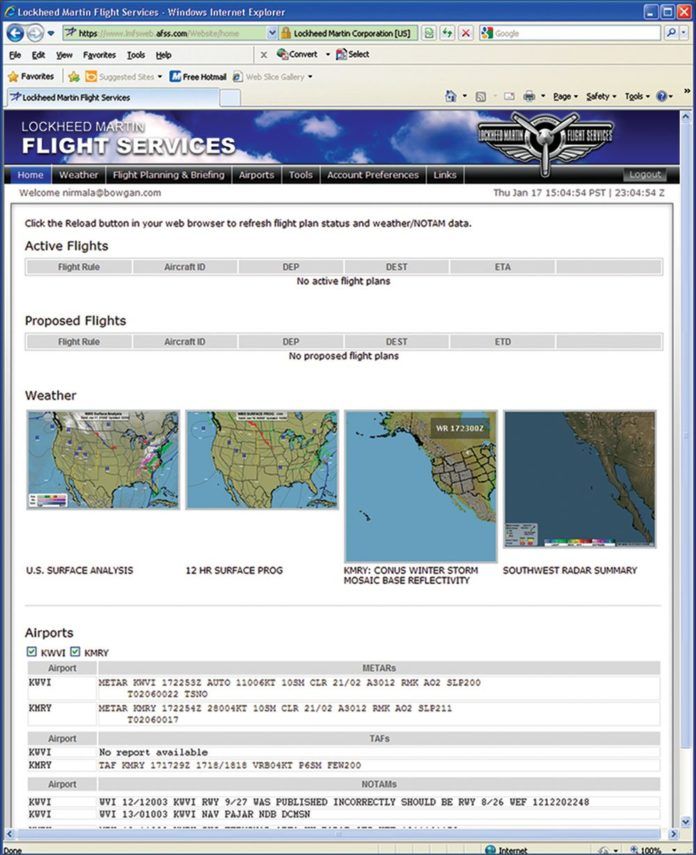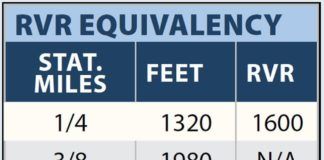At the AOPA Summit in October 2012 Lockheed Martin had a large and impressive display to announce the rollout of Flight Services (LMFS). Sigh…another flight planning app. Why bother? We took a look and concluded that the site has a lot to offer, but a lot to improve.
The Right Stuff
This particular tool comes straight from the source—the folks you talk to when you call 1-800-WX-BRIEF. When you self-brief through this application, you have access to almost everything that a briefer has in front of him/her when giving you the briefing over the telephone. Lockheed Martin states that 98% of what a telephone briefer uses is on the web site. That can be reassuring to information junkies such as pilots serious about flight planning. If that’s not enough to make you take notice of this new resource, you can sign up for LMFS’s Adverse Condition Alerting Service (ACAS).
ACAS issues alerts to pilots of adverse weather conditions, TFRs, and urgent PIREPs that arise in the time between when the pilot files the flight plan and when the pilot launches the flight. These alerts are sent via e-mail, text messages or Spider Tracks satellite service—up to eight different alerting methods. Lockheed Martin plans to migrate to ADS-B and issue alerts during the flight itself, which will be truly a useful feature. You specify the type of alerts you want to receive and how you want to receive them in your account preferences.
Another feature that you might find useful is the help you get in filing an ICAO flight plan through the LMFS’s website. In another article in this issue we try to demystify the alphabet soup that is the ICAO flight plan. Nevertheless, it can be pretty intimidating to fill out the ICAO form the first few times. The ICAO flight plan option under the Flight Planning and Briefing tab of the web site contains a lot of hints on what to fill into the various items on the form. Once the plan is filled out you can click a button to receive your briefing.
The first page of your briefing is the Alerts and Hazards to Flight which contains information on all those pesky TFRs that can be the undoing of the unwary pilot. This hazard alerting is another nice feature of the service and stems from the FAA’s stated goal to reduce the stubbornly high general aviation accident rate. Once you have reviewed your briefing, you can amend your flight plan before you file it. Another nice feature of this service is that once you file your flight plan it is instantly in the FSS system and can be pulled up by a briefer if you were to call them, you know, on the actual
telephone.
Quickie Briefing
We particularly liked the feature that allows you to set up three airports and four graphics weather products on your home page. If you were just going to your home airport to turn some gas into fun for a few hours, knowing the latest weather conditions forecast for your local area for the next few hours with a click or two from the home page is remarkably convenient.
And, yes, it also has an airport directory, but this one has a fresh look and some extremely detailed information. Entering the three-letter identifier and clicking on the Go button gives you a slew of information organized under eight sub-headings (LMFS calls these topics) as shown. Expanding each topic lets you access the relevant information. Airport diagrams and approach plates can also be accessed from the same page by clicking on the appropriate link. The LMFS site has a link to Skyvector.com for FBO information including fuel prices depicted right on a chart to facilitate price-based fuel planning. Unfortunately, fuel-price data isn’t as complete as at other sources, like AirNav.com.
In the near future LMFS is scheduled to roll out Surveillance Enhanced Search And Rescue (SAR). This service will tie in to some of the burgeoning tracking services and satellite devices to trigger an official response if the airborne device stops transmitting, appears stationary or if the pilot pushes the emergency call button on the device. The goal is to reduce the time between an aviation accident and the start of the search.
In Person
A number of years back we had an unexpected treat of getting an in-person briefing at one of the then few remaining Flight Service Stations. Seeing what the briefer saw in real time and having the ability to interact with him in person made for an extremely thorough and unforgettable briefing. LMFS has plans to provide this capability on its website in the future, where a pilot on the phone with a briefer can see what the briefer sees as the briefing proceeds.
The site provides a broad assortment of nicely presented graphical weather products, but we couldn’t find an option to decode the text products into plain language. If you aren’t fluent in METARese and TAFrench, LMFS has a Guide to Abbreviations that you can use to help decode these sometimes arcane reports.
Currently the data on the website isn’t summarized as nicely as a briefer would when you call on the phone. “Auto-summarization” is scheduled for release in 2013. We expect that will save the self-briefing pilot a lot of time.
The good news is that the LMFS web site is still under development. Try it out. There’s a tab for Pilot Feedback to let them know what you like and what you want improved (plain language briefings?) or what you wish were included in the service. For our first foray onto this site we see great promise and some useful features, but we don’t yet find the basic material compelling enough to cause us to change what we do now. As feedback is received and enhancements implemented, perhaps it will get there. Stay tuned.





